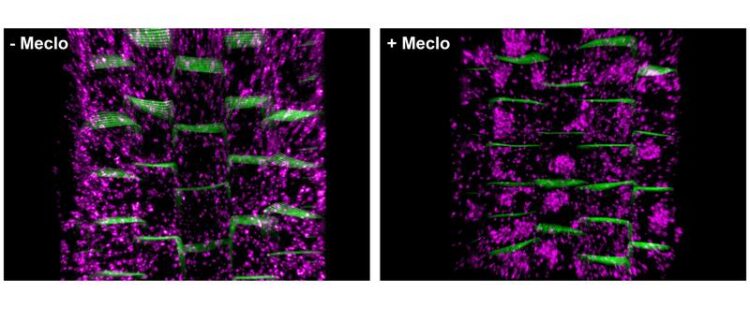Plants on Aspirin

Effects of Painkillers
Shutang Tan / IST Austria
Researchers at IST Austria gain deeper knowledge of plant growth by treating seedlings with painkillers like Aspirin and the like. New study published in Cell Reports.
For centuries humans were using willow barks to treat a headache or an inflamed tooth. Later, the active ingredient, the plant hormone salicylic acid, was used to develop painkillers like Aspirin. But what happens, if plants are treated with these painkillers? By doing so, Scientists at the Institute of Science and Technology (IST) Austria discovered an unexpected bioactivity of human pharmaceuticals in plants. The scientists published their study in the journal Cell Reports.
When pathogens enter a plant, infected cells set off an alarm before they die. They discharge methylsalicylic acid, which is later transformed into salicylic acid, triggering an immune response. Hence, salicylic acid is a stress signal in plants, but it also participates in regulating plant growth and development. In humans, salicylic acid proofed to be useful in a different way: Already in prehistoric times people realized that when they were drinking willow bark tea or taking other willow bark preparations, fever dropped and pain disappeared. Centuries later, scientists developed salicylic acid derivatives such as Aspirin and Ibuprofen. These so called non-steroidal anti-inflammatory drugs (NSAIDs) suppress the inflammatory response of mammalian cells, thereby making us feel better when we have a cold. But how do they affect plants?
Losing the sense of direction
“When I got the idea, I had a really serious toothache and I had some Ibuprofen at hands,” explains Shutang Tan, who at that time was a postdoc at the Institute of Science and Technology (IST) Austria working in the group of Professor Jiří Friml. “I simply used the tablets from the pharmacy and I took the same amount as in my previous experiments with salicylic acid. Then, I observed the effect of the Ibuprofen on Arabidopsis seedlings.” The primary roots of the plant were significantly shorter and instead of growing downward, they were curling up, unable to respond to gravity. Furthermore, the plants developed fewer or no lateral roots at all.
Together with colleagues at the IST Austria and six other research institutions Shutang Tan looked at the effects of 20 different painkillers on Arabidopsis seedlings. “We found that all of the painkillers we tested, including Aspirin and Ibuprofen, were interfering with the auxin flow,” explains Tan. The plant hormone auxin is essential for all developmental processes within a plant. It is especially responsible for a plants ability to stretch its leaves towards the sun and its roots towards the center of the earth. So called PIN proteins regulate the flow of auxin from one cell to the other, depending on which side of the cell they are sitting. If the PIN proteins are not at the right location within the cell, the flow of auxin is disturbed, leading to a faulty development of the plant. Hence, the painkillers seemed to interfere with the localization of the PIN proteins. But it didn’t stop there.
Complex dynamics within plant cells
Looking closely, the scientists discovered that the effect is not limited to PIN proteins, but that the drugs interfere with the whole endomembrane system, suppressing the movement and trafficking of substances within the cells. The painkillers impair the dynamics of the cytoskeleton of the cells, a network of interlinking proteins, which among many other things gives the cell its shape and is involved in the uptake of extracellular material. Together with Markus Geisler’s group at the University of Fribourg, Switzerland, the researchers at IST Austria uncovered that one group of painkillers, including the drugs Meclofenamic acid and Flufenamic acid, directly target an immunophilin-like protein, called TWISTED DWARF1, to realize these physiological and cellular activities.
Furthermore, the scientists were able to show, that NSAIDs have similar physiological and cell biological effects as auxin transport inhibitors – important chemical tools in cell biology, which interfere with the transport of auxin. “It would be very interesting to find out, if these auxin transport inhibitors can also be used as painkillers in animals. That is one big question we still need to answer” concludes Tan. Together with IST Professor Jiří Friml, Shutang Tan, who is now establishing his own laboratory at the University of Science and Technology of China, wants to investigate which additional proteins within the plant are targeted by the painkillers and what pathways they use to do so.
Originalpublikation:
Shutang Tan, Martin Di Donato, Matouš Glanc, Xixi Zhang, Petr Klima, Noel Ferro, Aurélien Bailly, Jan Petrášek, Markus Geisler, and Jiří Friml*. Non-steroidal anti-inflammatory drugs target TWISTED DWARF1-regulated actin dynamics and auxin transport-mediated development in plants. Cell Reports. 2020.33:108463. DOI: https://doi.org/10.1016/j.celrep.2020.108463.
Media Contact
All latest news from the category: Life Sciences and Chemistry
Articles and reports from the Life Sciences and chemistry area deal with applied and basic research into modern biology, chemistry and human medicine.
Valuable information can be found on a range of life sciences fields including bacteriology, biochemistry, bionics, bioinformatics, biophysics, biotechnology, genetics, geobotany, human biology, marine biology, microbiology, molecular biology, cellular biology, zoology, bioinorganic chemistry, microchemistry and environmental chemistry.
Newest articles

Microscopic basis of a new form of quantum magnetism
Not all magnets are the same. When we think of magnetism, we often think of magnets that stick to a refrigerator’s door. For these types of magnets, the electronic interactions…

An epigenome editing toolkit to dissect the mechanisms of gene regulation
A study from the Hackett group at EMBL Rome led to the development of a powerful epigenetic editing technology, which unlocks the ability to precisely program chromatin modifications. Understanding how…

NASA selects UF mission to better track the Earth’s water and ice
NASA has selected a team of University of Florida aerospace engineers to pursue a groundbreaking $12 million mission aimed at improving the way we track changes in Earth’s structures, such…





















